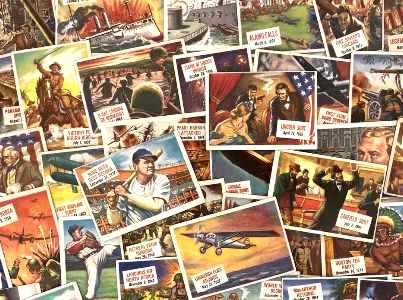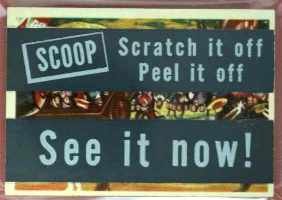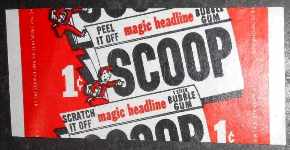1977 Topps ORIGINAL ARTWORK - ROBERTO CLEMENTE
The original ONE-OF-A-KIND Topps artwork for the Clemente comic on back of card #243 Ron Reed. Item comes with the vintage card.
| Grade |
NM/MINT |
| Book Value |
n/a |
| Our Price |
$ 1,495
Add to cart
|


Below are short bits & pieces on sportscard & baseball trading card collecting.
Please wander around the website for more info, prices, values & images
on vintage baseball, football, basketball, hockey, sport and non-sports cards.
1954 Topps Scoops

1954 Topps Scoops squeezes 1,000 years of history into a sharp (156) card set.
The cards, slightly smaller 2-1/16" x 2-15/16", were released in (2)
(78) card series. Each card had a colorful painting and caption
with date on front. Some were issued with a scratch-off area meant
hiding the headline so some cards are found with and without the
coating.

1954 Scoops covered many major events & people throughout history.
Mostly a non-sports set, many top sports stars like Babe Ruth,
Jesse Owens, Notre Dame's Four Horsemen, Joe Louis, Bob Feller
and Ben Hogan were included.


Backs are similar to a newspaper's front page with newspaper's name,
headline, date & location at top. The set seemed to focus on
disasters like the San Francisco Earthquake, Fire Sweeps Chicago,
Rome Burned, Pompeii Destroyed (#91); and wars: Battleship Maine
Blown Up, Alamo Falls, U.S. Troops Reach France, World War II
Begins, Victory in Europe & Napoleon Loses at Waterloo plus many
other events that shaped the world.
Click for complete
1954 Topps Scoops
Note: You may be on that page right now.
|

1933 Goudey Baseball Cards
Checklist & Values
1933 Goudey baseball cards were issued during the worst part of
The Great Depression. The set ended up at 240 cards (239 printed
in 1933 and one in 1934). In an effort to attract collectors,
several of the games top players were honored with multiple cards
including "The Great Bambino" who appeared on 4 different cards.
The Babe was once asked why he made more than the President of the
United States, the Babe answered simply: "I had a better year than he did."
The Elusive Nap Lajoie
One of the most important facts regarding the 1933 Goudey set was their
infamous marketing ploy. Goudey took "marketing" to a whole new level
to keep people buying packs by never issuing card #106. Collectors wrote
the Goudey Card Company complaining. They were rewarded with Goudey
sending them the un-issued card #106 (Nap Lajoie) in 1934.
Note: You may be on that page right now.
|

1991 Topps Desert Shield cards
Checklist & Values
The 792 card 1991 Topps Desert Shield Baseball card set was issued by
Topps for the soldiers serving in the Gulf War. The Desert Shield set is
a variation of Topps regular 1991 baseball card with each card having a
special gold-foiled 'Desert Shield' stamp added to the front.
Many of the cards, scooped up by military personnel stateside, never made
it overseas. The equivalent of approx 6,500 sets of cards were made.
Cards are still sought after and fairly scarce with complete sets
nearly impossible to find. Be aware of counterfeits. Fakes can easily be
determined by comparing the gold foil logo with a real Desert Shield card.
The Chipper Jones rookie is the key card in the set along with the usual
super stars like Nolan Ryan, Ken Griffey Jr., Cal Ripken ...
|

Tobacco Cards
Starting approximately in 1886, sportscards, mostly baseball cards, were often
included with tobacco products, for promotional purposes and also because the
card reinforced the packaging and protected cigarettes from damage. These sports
cards are referred to as tobacco cards in the baseball card hobby. Over the next
few years many different companies produced baseball cards. Tobacco cards soon
started to disappear as the American Tobacco Company tried to develop a monopoly
by buying out other companies.
They were reintroduced in the 1900s, as American Tobacco came under pressure from
antitrust action and Turkish competition. The most famous and most expensive,
baseball card is the rare T206 Honus Wagner. The card exists in very limited
quantities compared to others of its type because Wagner forced the card to be
removed from printing. It is widely (and incorrectly) believed that Wagner did
so because he refused to promote tobacco, but the true explanation lies in a
dispute over compensation.
Soon other companies also began producing baseball and football cards. Sports magazines
such as The Sporting News were early entries to the market. Candy manufacturers
soon joined the fray and reflected a shift toward a younger target audience for cards.
Caramel companies were particularly active and baseball cards were one of the first
prizes to be included in Cracker Jacks. World War I soon suppressed baseball card
production.





 1954 Topps Scoops squeezes 1,000 years of history into a sharp (156) card set.
The cards, slightly smaller 2-1/16" x 2-15/16", were released in (2)
(78) card series. Each card had a colorful painting and caption
with date on front. Some were issued with a scratch-off area meant
hiding the headline so some cards are found with and without the
coating.
1954 Topps Scoops squeezes 1,000 years of history into a sharp (156) card set.
The cards, slightly smaller 2-1/16" x 2-15/16", were released in (2)
(78) card series. Each card had a colorful painting and caption
with date on front. Some were issued with a scratch-off area meant
hiding the headline so some cards are found with and without the
coating.
 1954 Scoops covered many major events & people throughout history.
Mostly a non-sports set, many top sports stars like Babe Ruth,
Jesse Owens, Notre Dame's Four Horsemen, Joe Louis, Bob Feller
and Ben Hogan were included.
1954 Scoops covered many major events & people throughout history.
Mostly a non-sports set, many top sports stars like Babe Ruth,
Jesse Owens, Notre Dame's Four Horsemen, Joe Louis, Bob Feller
and Ben Hogan were included.

 Backs are similar to a newspaper's front page with newspaper's name,
headline, date & location at top. The set seemed to focus on
disasters like the San Francisco Earthquake, Fire Sweeps Chicago,
Rome Burned, Pompeii Destroyed (#91); and wars: Battleship Maine
Blown Up, Alamo Falls, U.S. Troops Reach France, World War II
Begins, Victory in Europe & Napoleon Loses at Waterloo plus many
other events that shaped the world.
Backs are similar to a newspaper's front page with newspaper's name,
headline, date & location at top. The set seemed to focus on
disasters like the San Francisco Earthquake, Fire Sweeps Chicago,
Rome Burned, Pompeii Destroyed (#91); and wars: Battleship Maine
Blown Up, Alamo Falls, U.S. Troops Reach France, World War II
Begins, Victory in Europe & Napoleon Loses at Waterloo plus many
other events that shaped the world.
